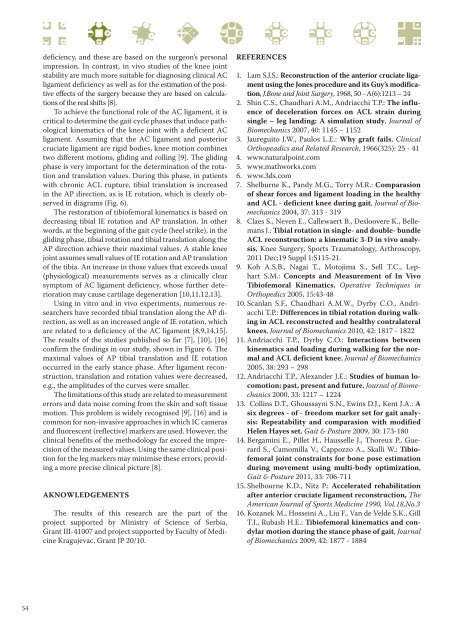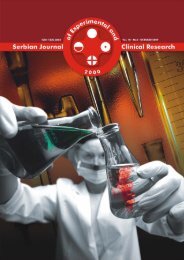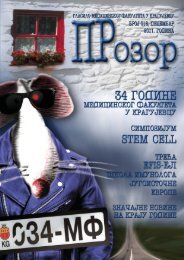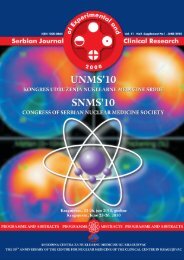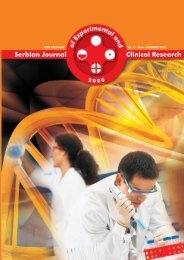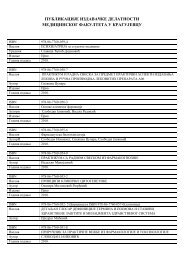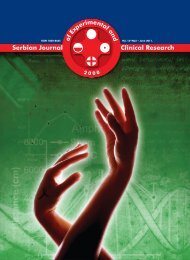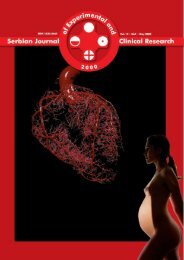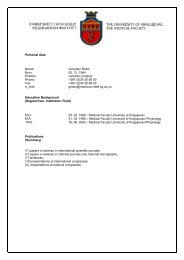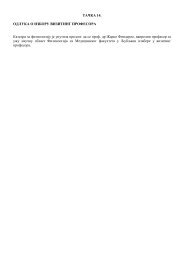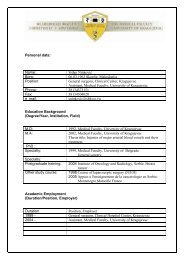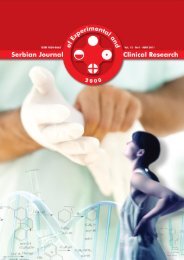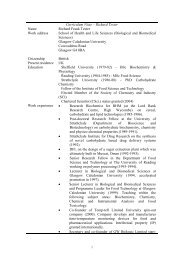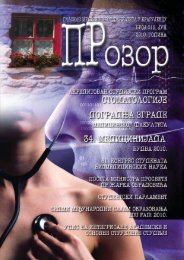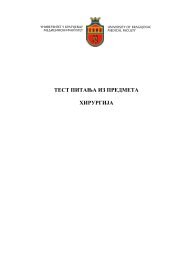Untitled - Medicinski fakultet Kragujevac - Univerzitet u Kragujevcu
Untitled - Medicinski fakultet Kragujevac - Univerzitet u Kragujevcu
Untitled - Medicinski fakultet Kragujevac - Univerzitet u Kragujevcu
You also want an ePaper? Increase the reach of your titles
YUMPU automatically turns print PDFs into web optimized ePapers that Google loves.
54<br />
deficiency, and these are based on the surgeon’s personal<br />
impression. In contrast, in vivo studies of the knee joint<br />
stability are much more suitable for diagnosing clinical AC<br />
ligament deficiency as well as for the estimation of the positive<br />
effects of the surgery because they are based on calculations<br />
of the real shifts [8].<br />
To achieve the functional role of the AC ligament, it is<br />
critical to determine the gait cycle phases that induce pathological<br />
kinematics of the knee joint with a deficient AC<br />
ligament. Assuming that the AC ligament and posterior<br />
cruciate ligament are rigid bodies, knee motion combines<br />
two different motions, gliding and rolling [9]. The gliding<br />
phase is very important for the determination of the rotation<br />
and translation values. During this phase, in patients<br />
with chronic ACL rupture, tibial translation is increased<br />
in the AP direction, as is IE rotation, which is clearly observed<br />
in diagrams (Fig. 6).<br />
The restoration of tibiofemoral kinematics is based on<br />
decreasing tibial IE rotation and AP translation. In other<br />
words, at the beginning of the gait cycle (heel strike), in the<br />
gliding phase, tibial rotation and tibial translation along the<br />
AP direction achieve their maximal values. A stable knee<br />
joint assumes small values of IE rotation and AP translation<br />
of the tibia. An increase in those values that exceeds usual<br />
(physiological) measurements serves as a clinically clear<br />
symptom of AC ligament deficiency, whose further deterioration<br />
may cause cartilage degeneration [10,11,12,13].<br />
Using in vitro and in vivo experiments, numerous researchers<br />
have recorded tibial translation along the AP direction,<br />
as well as an increased angle of IE rotation, which<br />
are related to a deficiency of the AC ligament [8,9,14,15].<br />
The results of the studies published so far [7], [10], [16]<br />
confirm the findings in our study, shown in Figure 6. The<br />
maximal values of AP tibial translation and IE rotation<br />
occurred in the early stance phase. After ligament reconstruction,<br />
translation and rotation values were decreased,<br />
e.g., the amplitudes of the curves were smaller.<br />
The limitations of this study are related to measurement<br />
errors and data noise coming from the skin and soft tissue<br />
motion. This problem is widely recognised [9], [16] and is<br />
common for non-invasive approaches in which IC cameras<br />
and fluorescent (reflective) markers are used. However, the<br />
clinical benefits of the methodology far exceed the imprecision<br />
of the measured values. Using the same clinical position<br />
for the leg markers may minimise these errors, providing<br />
a more precise clinical picture [8].<br />
AKNOWLEDGEMENTS<br />
The results of this research are the part of the<br />
project supported by Ministry of Science of Serbia,<br />
Grant III-41007 and project supported by Faculty of Medicine<br />
<strong>Kragujevac</strong>, Grant JP 20/10.<br />
REFERENCES<br />
1. Lam S.J.S.: Reconstruction of the anterior cruciate ligament<br />
using the Jones procedure and its Guy’s modification,<br />
J.Bone and Joint Surgery, 1968, 50 - A(6):1213 – 24<br />
2. Shin C.S., Chaudhari A.M., Andriacchi T.P.: The influence<br />
of deceleration forces on ACL strain during<br />
single – leg landing: A simulation study, Journal of<br />
Biomechanics 2007, 40: 1145 – 1152<br />
3. Jaureguito J.W., Paulos L.E.: Why graft fails, Clinical<br />
Orthopeadics and Related Research, 1966(325): 25 - 41<br />
4. www.naturalpoint.com<br />
5. www.mathworks.com<br />
6. www.3ds.com<br />
7. Shelburne K., Pandy M.G., Torry M.R.: Comparasion<br />
of shear forces and ligament loading in the healthy<br />
and ACL - deficient knee during gait, Journal of Biomechanics<br />
2004, 37: 313 - 319<br />
8. Claes S., Neven E., Callewaert B., Desloovere K., Bellemans<br />
J.: Tibial rotation in single- and double- bundle<br />
ACL reconstruction: a kinematic 3-D in vivo analysis,<br />
Knee Surgery, Sports Traumatology, Arthroscopy,<br />
2011 Dec;19 Suppl 1:S115-21.<br />
9. Koh A.S.B., Nagai T., Motojima S., Sell T.C., Lephart<br />
S.M.: Concepts and Measurement of In Vivo<br />
Tibiofemoral Kinematics, Operative Techniques in<br />
Orthopedics 2005, 15:43-48<br />
10. Scanlan S.F., Chaudhari A.M.W., Dyrby C.O., Andriacchi<br />
T.P.: Differences in tibial rotation during walking<br />
in ACL reconstructed and healthy contralateral<br />
knees, Journal of Biomechanics 2010, 42: 1817 - 1822<br />
11. Andriacchi T.P., Dyrby C.O.: Interactions between<br />
kinematics and loading during walking for the normal<br />
and ACL deficient knee, Journal of Biomechanics<br />
2005, 38: 293 – 298<br />
12. Andriacchi T.P., Alexander J.E.: Studies of human locomotion:<br />
past, present and future, Journal of Biomechanics<br />
2000, 33: 1217 – 1224<br />
13. Collins D.T., Ghoussayni S.N., Ewins D.J., Kent J.A.: A<br />
six degrees - of - freedom marker set for gait analysis:<br />
Repeatability and comparasion with modified<br />
Helen Hayes set, Gait & Posture 2009, 30: 173-180<br />
14. Bergamini E., Pillet H., Hausselle J., Thoreux P., Guerard<br />
S., Camomilla V., Cappozzo A., Skalli W.: Tibiofemoral<br />
joint constraints for bone pose estimation<br />
during movement using multi-body optimization,<br />
Gait & Posture 2011, 33: 706-711<br />
15. Shelbourne K.D., Nitz P.: Accelerated rehabilitation<br />
after anterior cruciate ligament reconstruction, The<br />
American Journal of Sports Medicine 1990, Vol.18,No.3<br />
16. Kozanek M., Hosseini A., Liu F., Van de Velde S.K., Gill<br />
T.J., Rubash H.E.: Tibiofemoral kinematics and condylar<br />
motion during the stance phase of gait, Journal<br />
of Biomechanics 2009, 42: 1877 - 1884


